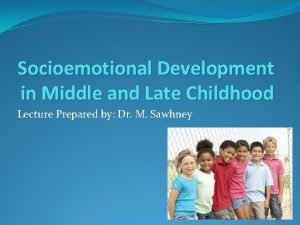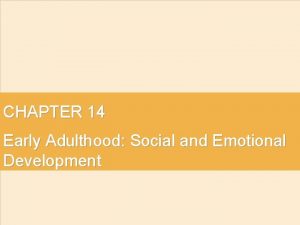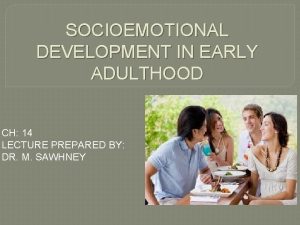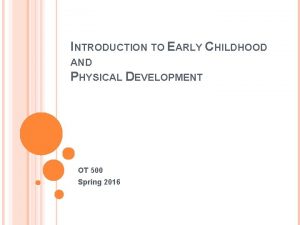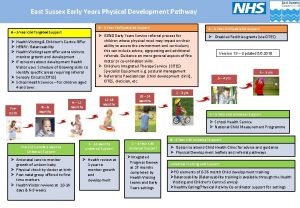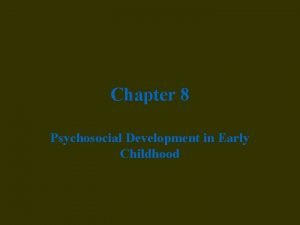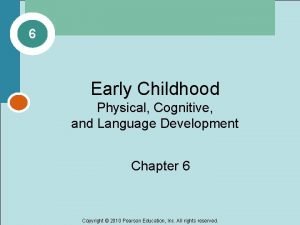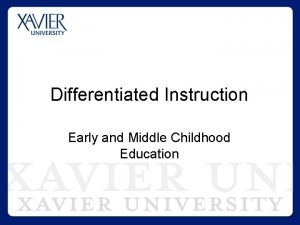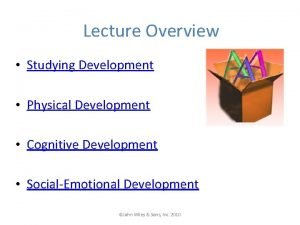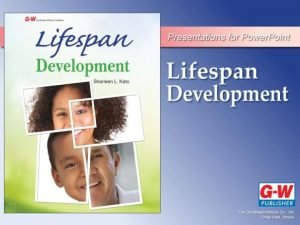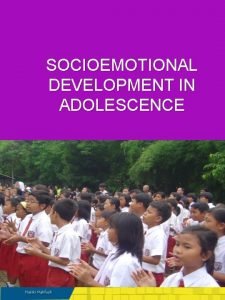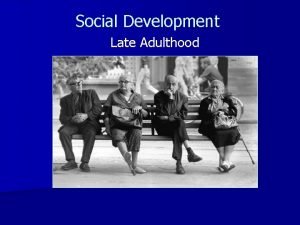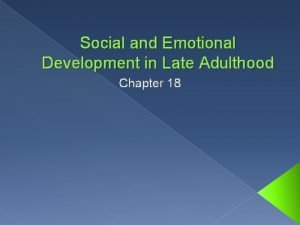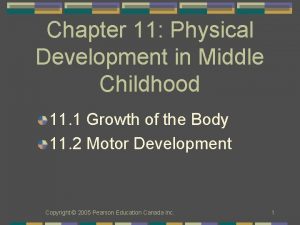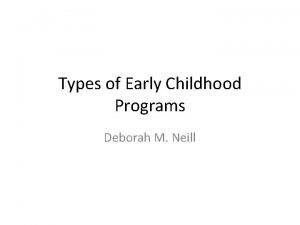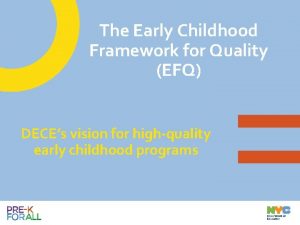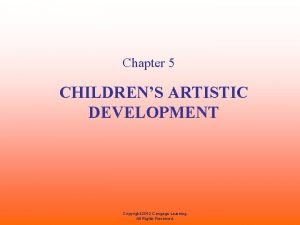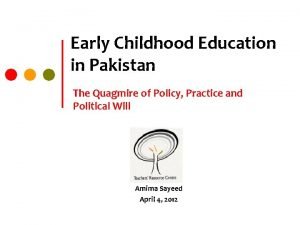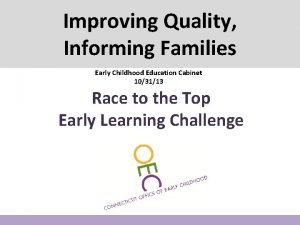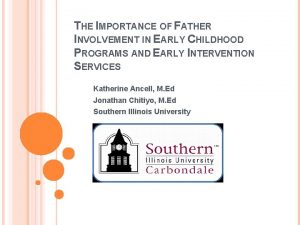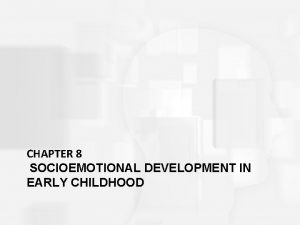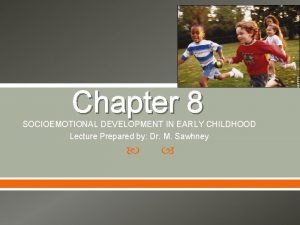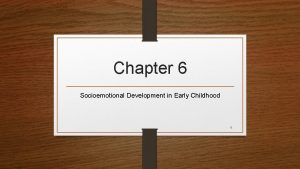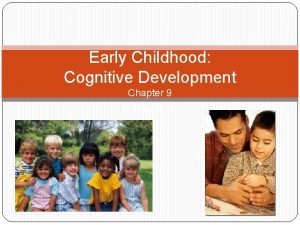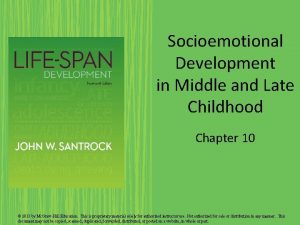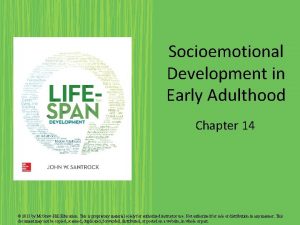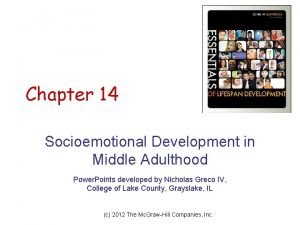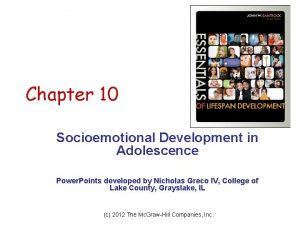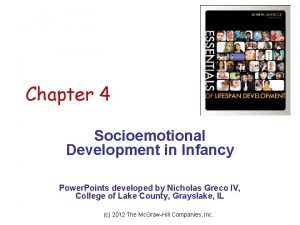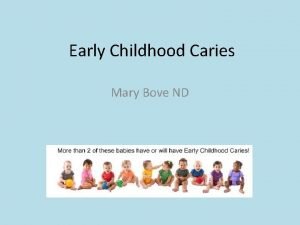Chapter 6 Socioemotional Development in Early Childhood Power





















































- Slides: 53

Chapter 6 Socioemotional Development in Early Childhood Power. Points developed by Nicholas Greco IV, College of Lake County, Grayslake, IL (c) 2012 The Mc. Graw-Hill Companies, Inc.

Initiative Versus Guilt § Erikson’s third stage: initiative versus guilt üchildren use their perceptual, motor, cognitive, and language skills to make things happen üon their own initiative, children exuberantly move out into a wider social world ügovernor of initiative is conscience üinitiative leads not only to rewards but also guilt, which lowers self-esteem (c) 2012 The Mc. Graw-Hill Companies, Inc.

Self-Understanding § Self-understanding -- representation of self -- the substance and content of selfconceptions § Early self-understanding involves selfrecognition üYoung children think that the self can be described by many material characteristics, such as size, shape, and color üAbout 4 to 5 years of age, they begin to include psychological trait and emotion terms in their own self-descriptions (c) 2012 The Mc. Graw-Hill Companies, Inc.

Understanding Others § Young children’s theory of mind includes understanding that other people have emotions and desires § About 4 to 5 years, they begin to perceive others in terms of psychological traits § Some young children are better than others at understanding what people are feeling and what they desire (c) 2012 The Mc. Graw-Hill Companies, Inc.

Emotional Development § Awareness of self is linked to the ability to feel an expanding range of emotions § To experience self-conscious emotions, children must be able to refer to themselves and be aware of themselves as distinct from others § Important changes in emotional development: increased ability to talk about one’s own and others’ emotions üincrease the number of terms they use to describe emotions (c) 2012 The Mc. Graw-Hill Companies, Inc.

Emotion-Coaching and Emotion-Dismissing Parents § Emotion-coaching parents monitor their children’s emotions, view their children’s negative emotions as opportunities for teaching, assist them in labeling emotions, and coach them in how to deal effectively with emotions § Emotion-dismissing parents view their role as to deny, ignore, or change negative emotions (c) 2012 The Mc. Graw-Hill Companies, Inc.

Regulation of Emotion and Peer Relations § Emotions play a strong role in determining the success of a child’s peer relationships § Ability to modulate one’s emotions is an important skill that benefits relationships with peers ümoody and emotionally negative children experience rejection by their peers üpositive children are more popular (c) 2012 The Mc. Graw-Hill Companies, Inc.

Moral Development § Moral development -- development of thoughts, feelings, and behaviors regarding rules and conventions about what people should do in their interactions with other people üFreudian theory, superego = the moral element of personality § Empathy -- responding to another person’s feelings with an emotion that echoes the other’s feelings (Eisenberg & others, 2009) (c) 2012 The Mc. Graw-Hill Companies, Inc.

Moral Reasoning § Piaget (1932) theorized how thinking about moral issues was stimulated üAges 4– 7: heteronomous morality -- children think of justice and rules as unchangeable properties of the world, removed from the control of people ü 7– 10 years of age, children are in a transition ü 10 years and older: autonomous morality -- aware that rules and laws are created by people (c) 2012 The Mc. Graw-Hill Companies, Inc.

Moral Reasoning § Because young children are heteronomous moralists, they judge the rightness or goodness of behavior by considering its consequences, not the intentions of the actor § The heteronomous thinker also believes in immanent justice -- the concept that if a rule is broken, punishment will be meted out immediately (c) 2012 The Mc. Graw-Hill Companies, Inc.

Moral Behavior § Behavioral and social cognitive approach -- processes of reinforcement, punishment, and imitation explain the development of moral behavior § When rewarded for behavior that is consistent with laws and social conventions, they are likely to repeat that behavior § Actions of models who behave morally are likely to be adopted (c) 2012 The Mc. Graw-Hill Companies, Inc.

Moral Behavior § Behavioral and social cognitive researchers emphasize that what children do in one situation is often only weakly related to what they do in other situations § The totally honest child was virtually nonexistent, as was the totally dishonest child § Ability to resist temptation is closely tied to the development of self-control (Hartshorne & May, 1928– 1930; Mischel, 2004) (c) 2012 The Mc. Graw-Hill Companies, Inc.

Gender § Gender -- social and psychological dimensions of being male or female § Gender identity -- sense of being male or female § Gender roles -- sets of expectations that prescribe how females or males should think, act, and feel üpreschool children act in ways that match their culture's gender roles and exhibit a sense of gender identity (c) 2012 The Mc. Graw-Hill Companies, Inc.

Social Theories of Gender § Social role theory -- contrasting roles of women and men § Psychoanalytic theory of gender -- Freud’s view -- preschool child develops a sexual attraction to the opposite-sex parent üOedipus (for boys) or Electra (for girls) complex § Social cognitive theory of gender -- by observing and imitating and through being rewarded and punished (c) 2012 The Mc. Graw-Hill Companies, Inc.

Parental Influences on Gender Development § By action and by example, parents influence their children’s gender development ücultures around the world give mothers and fathers different roles üMothers’ Socialization Strategies -- mothers socialize their daughters to be more obedient and responsible than their sons üFathers’ Socialization Strategies -- fathers show more attention to sons than daughters, engage in more activities with sons, and put forth more effort to promote sons’ intellectual development (Grusec & Davidov, 2007) (c) 2012 The Mc. Graw-Hill Companies, Inc.

Peer Influences § Peers prompt the process of responding to and modeling masculine and feminine behavior üplayground has been called “gender school” § Peers extensively reward and punish gender behavior üpeers often reject children who act in a manner that is characteristic of the other gender § Gender molds important aspects of peer relations (Luria & Herzog, 1985; Leaper & Friedman, 2007; Matlin, 2008) (c) 2012 The Mc. Graw-Hill Companies, Inc.

(c) 2012 The Mc. Graw-Hill Companies, Inc.

Theories of Gender Development § Social Cognitive Theory ümechanisms by which gender develops üobservation üimitation ürewards and punishment § Gender Schema Theory ügender typing emerges as children gradually develop gender schemas of what is genderappropriate and gender-inappropriate in their culture ügender schema -- organizes the world in terms of female and male (Martin & Ruble, 2010) (c) 2012 The Mc. Graw-Hill Companies, Inc.

Baumrind’s Parenting Styles § Diana Baumrind (1971) has described four types of parenting styles ü authoritarian parenting -- restrictive, punitive style demanding obedience and respect ü authoritative parenting -- encourages independence but still places limits and controls ü neglectful parenting -- parent is very uninvolved in the child's life ü indulgent parenting -- highly involved with but place few demands or controls § There are ethic differences which may be associated with more positive outcomes than Baumrind predicts (c) 2012 The Mc. Graw-Hill Companies, Inc.

Insert Figure 6. 2 (c) 2012 The Mc. Graw-Hill Companies, Inc.

Punishment § Corporal (physical) punishment historically has been considered a necessary and even desirable method of discipline § Use of corporal punishment is legal in every state in America § Individuals in the United States and Canada were among those with the most favorable attitudes toward corporal punishment and were the most likely to remember it being used by their parents (Curran & others, 2001) (c) 2012 The Mc. Graw-Hill Companies, Inc.

Consequences of Corporal Punishment § Corporal punishment is associated with üHigher levels of immediate compliance, but also with increased aggression by the children üLower levels of moral internalization and mental health üMore adjustment problems üAdolescent depression üJuvenile delinquency (Gershoff, 2002; Bender & others, 2007) (c) 2012 The Mc. Graw-Hill Companies, Inc.

Reasons to Avoid Physical Punishment § Parents who spank present children with an out-of-control model which the children may then imitate § Punishment can instill fear, rage, or avoidance in children § Punishment tells the child what not to do rather than what to do § Punishment can be abusive (Durrant, 2008) (c) 2012 The Mc. Graw-Hill Companies, Inc.

Coparenting and Alternatives to Corporal Punishment § Handling misbehavior by reasoning and especially explaining the consequences of the child’s actions § Time out -- the child is briefly removed from the setting § Coparenting -- the support that parents provide one another in jointly raising a child (c) 2012 The Mc. Graw-Hill Companies, Inc.

Child Maltreatment § Eighty-four percent of children, who were abused according to a 2008 report, were abused by a parent or parents § In 2006, approximately 905, 000 U. S. children were victims of child abuse (U. S. Department of Health and Human Services, 2008) (c) 2012 The Mc. Graw-Hill Companies, Inc.

Types of Child Maltreatment § Physical abuse üthe infliction of physical injury § Child neglect üfailure to provide for the child’s basic needs § Sexual abuse üfondling a child’s genitals, intercourse, incest, rape, sodomy, etc. § Emotional abuse üpsychological/verbal abuse/mental injury üacts/omissions that have caused, or could cause, serious behavioral, cognitive, or emotional problems (c) 2012 The Mc. Graw-Hill Companies, Inc.

The Context of Abuse § No single factor causes child maltreatment § A combination of factors includes: üThe culture üFamily characteristics üDevelopmental characteristics of the child § About one-third of parents who were abused themselves go on to abuse their own children (c) 2012 The Mc. Graw-Hill Companies, Inc.

Developmental Consequences of Abuse § Poor emotion regulation, attachment problems, problems in peer relations, difficulty in adapting to school, and other psychological problems such as depression and delinquency § Difficulty in establishing and maintaining healthy intimate relationships § As adolescents and adults, they are at higher risk for violent romantic relationships, as well as for substance abuse, sexual risk taking, financial and employment-related difficulties (c) 2012 The Mc. Graw-Hill Companies, Inc.

Prevention of Maltreatment § In a recent study, two treatments were effective in reducing child maltreatment: ühome visitation that emphasized improved parenting, coping with stress, and increasing support for the mother üparent-infant psychotherapy that focused on improving maternal-infant attachment (Cicchetti, Toth, &Rogosch, 2005) (c) 2012 The Mc. Graw-Hill Companies, Inc.

Sibling Relationships § Approximately 80 percent of American children have one or more siblings § Interactions with siblings include aggressive, hostile interchanges § Conflict is only one of the many dimensions of sibling relations üsibling relations include helping, sharing, teaching, fighting, and playing (c) 2012 The Mc. Graw-Hill Companies, Inc.

Characteristics of Sibling Relationships § Emotional quality of the relationship ümany children and adolescents have mixed feelings toward their siblings § Familiarity and intimacy of the relationship üthey can either provide support or tease and undermine each other, depending on the situation § Variation in sibling relationships üsome siblings describe their relationships more positively than others (Dunn, 2007) (c) 2012 The Mc. Graw-Hill Companies, Inc.

Birth Order § First-born children ümore adult-oriented ümore helpful, conforming, and self-controlled § Only children often are achievementoriented and display a desirable personality, especially in comparison with later-borns and children from large families (c) 2012 The Mc. Graw-Hill Companies, Inc.

Changing Family in a Changing Society § The United States has one of the highest percentages of single-parent families in the world § Among two-parent families, there are those in which both parents work, or have divorced parents who have remarried, or gay or lesbian parents § Differences in culture and SES also influence families (c) 2012 The Mc. Graw-Hill Companies, Inc.

(c) 2012 The Mc. Graw-Hill Companies, Inc.

Working Parents § The nature of parents’ work rather than whether one parent works outside the home is significant üParents who have poor working conditions are likely to be more irritable at home and engage in less effective parenting üA consistent finding is that children (especially girls) of working mothers engage in less gender stereotyping and have more egalitarian views of gender (c) 2012 The Mc. Graw-Hill Companies, Inc.

Children in Divorced Families § Children in divorced families are more likely to ü have academic problems ü show externalized problems (such as acting out and delinquency) and internalized problems (such as anxiety and depression) ü have less competent intimate relationships ü drop out of school ü become sexually active at an early age ü take drugs ü to become sexually active at an early age ü have low self-esteem § A majority of children in divorced families do not have significant adjustment problems (c) 2012 The Mc. Graw-Hill Companies, Inc.

Divorce Adjustment § When a divorced parents’ relationship with each other is harmonious and when they use authoritative parenting, the adjustment of children improves § Children who are socially mature and responsible, who show few behavioral problems, and who have an easy temperament are better able to cope § Children with a difficult temperament often have problems in coping with their parents’ divorce (c) 2012 The Mc. Graw-Hill Companies, Inc.

Socioeconomic Issues of Divorce § Custodial mothers experience the loss of about one-fourth to one-half of their predivorce income § This income loss for divorced mothers is accompanied by increased workloads, high rates of job instability, and residential moves to less desirable neighborhoods with inferior schools § Custodial fathers have a loss of only onetenth of their pre-divorce income (c) 2012 The Mc. Graw-Hill Companies, Inc.

Gay Male and Lesbian Parents § Approximately 20 percent of lesbians and 10 percent of gay men are parents § Many lesbian mothers and gay fathers are non-custodial parents because they lost custody of their children to heterosexual spouses after a divorce § Most children of gay and lesbian parents were born in a heterosexual relationship that ended in a divorce § Parenthood among lesbians and gay men is controversial (c) 2012 The Mc. Graw-Hill Companies, Inc.

Cultural, Ethnic, and Socioeconomic Variations § Families in many countries are experiencing cultural change because of ü frequent international travel ü the Internet and electronic communications ü economic globalization ü greater family mobility ü migration to urban areas ü separation as some family members work in cities or other countries ü smaller families and fewer extended-family households ü increases in maternal employment (c) 2012 The Mc. Graw-Hill Companies, Inc.

Cultural, Ethnic, and Socioeconomic Variations § Families within different ethnic groups differ in their size, structure, composition, reliance on kinships networks, and levels of income and education § When children spend time in a child-care center, school, church, or other community setting, they are likely to learn the values and behaviors of the dominant culture üthey may be expected to adapt to that culture’s norms -- acculturation (c) 2012 The Mc. Graw-Hill Companies, Inc.

Cultural, Ethnic, and Socioeconomic Variations § Lower-SES parents ümore concerned that children conform to society’s expectations ücreate a home atmosphere where parents have authority üuse physical punishment more üare more directive and less conversational with their children (c) 2012 The Mc. Graw-Hill Companies, Inc.

Cultural, Ethnic, and Socioeconomic Variations § Higher-SES parents üare more concerned with developing children's initiative and delay of gratification ücreate an atmosphere in which children are more nearly equal participants ürules are discussed üare less likely to use physical punishment üare less directive and more conversational with their children (c) 2012 The Mc. Graw-Hill Companies, Inc.

Peer Relations § Peers -- children of about the same age or maturity level § Functions of a child’s peer group üreceive feedback about their abilities ücan be necessary for normal socioemotional development ünegotiating roles and rules in play, arguing, and agreeing (c) 2012 The Mc. Graw-Hill Companies, Inc.

Play § Extensive amount of peer interaction during childhood involves play § Play -- pleasurable activity that is engaged in for its own sake § Its functions and forms vary § Therapists use play therapy both to allow the child to work off frustrations and to analyze the child’s conflicts and ways of coping with them (c) 2012 The Mc. Graw-Hill Companies, Inc.

Parten’s Classic Study of Play § Parten’s proposed the following types of play: üUnoccupied play üSolitary play üOnlooker play üParallel play üAssociative play üCooperative play (c) 2012 The Mc. Graw-Hill Companies, Inc.

Types of Play § Most widely studied types of children’s play üsensorimotor and practice play üpretense/symbolic play üsocial play üconstructive play ügames (c) 2012 The Mc. Graw-Hill Companies, Inc.

Types of Play § Sensorimotor play is behavior by infants intended to derive pleasure from exercising their sensorimotor schemes § Practice play involves the repetition of behavior when new skills are being learned or when physical or mental mastery and coordination of skills are required for games or sports (c) 2012 The Mc. Graw-Hill Companies, Inc.

Types of Play § Pretense/symbolic play occurs when the child transforms the physical environment into a symbol § Social play involves interaction with peers § Constructive play combines sensorimotor/practice play with symbolic representation § Games are activities that are engaged in for pleasure and have rules (c) 2012 The Mc. Graw-Hill Companies, Inc.

Television § Television is the most influential of the many types of mass media that affect children’s behavior § Many spend more time in front of the television set than they do with their parents üaverage of 2 to 4 hours a day (c) 2012 The Mc. Graw-Hill Companies, Inc.

Television § Negative influence on children by ümaking them passive learners üdistracting them from doing homework üteaching them stereotypes üproviding them with violent models of aggression üpresenting them with unrealistic views of the world (c) 2012 The Mc. Graw-Hill Companies, Inc.

Television § Positive influence on children’s development by üpresenting motivating educational programs üincreasing their information about the world beyond their immediate environment üproviding models of prosocial behavior (c) 2012 The Mc. Graw-Hill Companies, Inc.

Effects of Television on Children’s Aggression § Saturday morning cartoon shows average more than 25 violent acts per hour § Increased concern about children who play violent video games, especially those that are highly realistic (c) 2012 The Mc. Graw-Hill Companies, Inc.
 Late childhood social development
Late childhood social development Social development early adulthood
Social development early adulthood Early adulthood socioemotional development
Early adulthood socioemotional development Early and middle childhood
Early and middle childhood Early childhood is ____ for language learning
Early childhood is ____ for language learning Socioemotional development in infancy
Socioemotional development in infancy Socioemotional development in late adulthood
Socioemotional development in late adulthood Middle adulthood emotional
Middle adulthood emotional Fine motor skills development in early childhood
Fine motor skills development in early childhood Physical development in early childhood
Physical development in early childhood Psychosocial development in early childhood
Psychosocial development in early childhood Language development in early childhood
Language development in early childhood What is biosocial development in early childhood
What is biosocial development in early childhood Early childhood development with differentiated instruction
Early childhood development with differentiated instruction Physical development in early childhood
Physical development in early childhood Types of early childhood programs activity a chapter 2
Types of early childhood programs activity a chapter 2 Chapter 7 early childhood ages 3 through 5
Chapter 7 early childhood ages 3 through 5 Socioemotional maintenance definition sociology
Socioemotional maintenance definition sociology It is a self-portrait composed of many pieces
It is a self-portrait composed of many pieces Disengagement theory
Disengagement theory Elders' housing preferences reflect a strong desire for
Elders' housing preferences reflect a strong desire for Physical development in middle childhood chapter 11
Physical development in middle childhood chapter 11 Types of early childhood programs
Types of early childhood programs Elof standards 3k
Elof standards 3k Efq
Efq Pdp early childhood education and training program
Pdp early childhood education and training program Welcome dear parents
Welcome dear parents Acecqa self assessment tool
Acecqa self assessment tool Leonardo da vinci's childhood
Leonardo da vinci's childhood Trends in early childhood education
Trends in early childhood education Early childhood research quarterly
Early childhood research quarterly Early childhood ireland garda vetting
Early childhood ireland garda vetting Schirrmacher stages of artistic development
Schirrmacher stages of artistic development Facts about amelia earhart's childhood
Facts about amelia earhart's childhood Prosposed
Prosposed Pedagogical leadership skills
Pedagogical leadership skills Isaac newton early childhood
Isaac newton early childhood Eminem early childhood
Eminem early childhood Ece in pakistan
Ece in pakistan Early childhood education in bangladesh
Early childhood education in bangladesh Bellfort early childhood center
Bellfort early childhood center Associates in early childhood education jobs
Associates in early childhood education jobs Brownsburg early childhood center
Brownsburg early childhood center Attainment targets barbados
Attainment targets barbados Early childhood education
Early childhood education Kentucky governor's office of early childhood
Kentucky governor's office of early childhood Connecticut early childhood education cabinet
Connecticut early childhood education cabinet Minneapolis preschool screening instrument-revised (mpsi-r)
Minneapolis preschool screening instrument-revised (mpsi-r) Smyth reflection example
Smyth reflection example Influences on rizal’s boyhood
Influences on rizal’s boyhood Flushing latchkey
Flushing latchkey Skinner theory
Skinner theory Father involvement activities
Father involvement activities Holistic approach in early childhood education
Holistic approach in early childhood education
